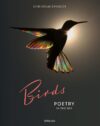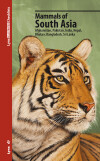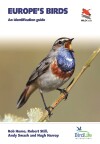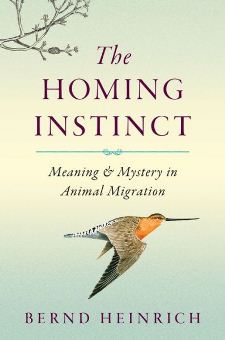 The Homing Instinct: Meaning and Mystery in Animal Migration
The Homing Instinct: Meaning and Mystery in Animal Migration
by Bernd Heinrich
From Houghton Mifflin Harcourt:
Acclaimed scientist and author Bernd Heinrich has returned every year since boyhood to a beloved patch of western Maine woods. What is the biology in humans of this deep-in-the-bones pull toward a particular place, and how is it related to animal homing?
Heinrich explores the fascinating science chipping away at the mysteries of animal migration: how geese imprint true visual landscape memory; how scent trails are used by many creatures, from fish to insects to amphibians, to pinpoint their home if they are displaced from it; and how the tiniest of songbirds are equipped for solar and magnetic orienteering over vast distances. Most movingly, Heinrich chronicles the spring return of a pair of sandhill cranes to their home pond in the Alaska tundra. With his trademark “marvelous, mind-altering” prose (Los Angeles Times), he portrays the unmistakable signs of deep psychological emotion in the newly arrived birds—and reminds us that to discount our own emotions toward home is to ignore biology itself.
While not exclusively about birds, this should be a good, informative read.
The Homing Instinct: Meaning and Mystery in Animal Migration
by Bernd Heinrich
Hardcover; 367 pages
Houghton Mifflin Harcourt; April 8, 2014
ISBN: 978-0547198484
$27.00
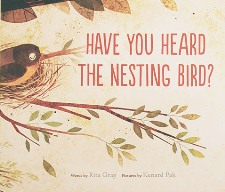 Have You Heard the Nesting Bird?
Have You Heard the Nesting Bird?
by Rita Gray (Author) and Kenard Pak (Illustrator)
From Houghton Mifflin Harcourt:
Woodpecker calls from a tree, “cuk-cuk-cuk.” Starling sings, “whistle-ee-wee.” But have you heard the nesting bird?
In this book, we hear all the different bird calls in counterpoint to the pervasive quiet of a mama bird waiting for her eggs to hatch. Fun and informative back matter takes the shape of an interview so that readers learn more right from the bird’s bill. Ken Pak’s lively illustrations, paired with Rita Gray’s words, render a visual and sonorous picture book to be enjoyed by young naturalists.
This is a charming children’s book, with a suggested age range of 4 – 8 years. I like the illustrations and, if my children are any indication, reading aloud the rendered bird sounds will be a big hit. My four-year-old daughter definitely enjoyed me reading this to her.
Have You Heard the Nesting Bird?
by Rita Gray (Author) and Kenard Pak (Illustrator)
Hardcover; 32 pages
Houghton Mifflin Harcourt; March 18, 2014
ISBN: 978-0544105805
$16.99
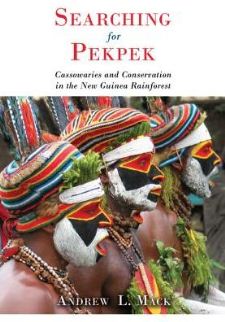 Searching for Pekpek: Cassowaries and Conservation in the New Guinea Rainforest
Searching for Pekpek: Cassowaries and Conservation in the New Guinea Rainforest
by Andrew L. Mack
From Cassowary Conservation and Publishing:
Andrew Mack immersed himself in a vast expanse of roadless, old growth rainforest of Papua New Guinea in 1987.
He and his co-investigator Debra Wright, built a research station by hand and lived there for years. Their mission was to study the secretive and perhaps most dinosaur-like creature still roaming the planet: the cassowary.
The ensuing adventures of this unorthodox biologist–studying seeds found in cassowary droppings (pekpek), learning to live among the indigenous Pawai’ia, traversing jungles, fighting pests and loneliness, struggling against unscrupulous oil speculators, and more–are woven into a compelling tale that spans two decades. Mack shares the insights he garnered about rainforest ecology while studying something as seemingly mundane as cassowary pekpek. He ultimately gained profound insight into why conservation is failing in places like Papua New Guinea and struggled to create a more viable strategy for conserving some of Earth’s last wild rainforests.
This promises to be an interesting book, even without the giant, dinosaur-like birds that can – and do – kill people. (Yes, I think Cassowaries are cool!)
Searching for Pekpek: Cassowaries and Conservation in the New Guinea Rainforest
by Andrew L. Mack
Paperback; 253 pages
Cassowary Conservation and Publishing; March 11, 2014
ISBN: 978-0989390309
$19.95
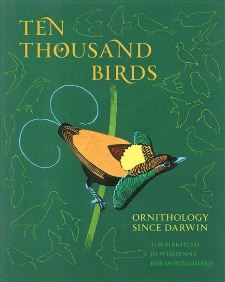 Ten Thousand Birds: Ornithology since Darwin
Ten Thousand Birds: Ornithology since Darwin
by Tim Birkhead, Jo Wimpenny, and Bob Montgomerie
From Princeton University Press:
Ten Thousand Birds provides a thoroughly engaging and authoritative history of modern ornithology, tracing how the study of birds has been shaped by a succession of visionary and often-controversial personalities, and by the unique social and scientific contexts in which these extraordinary individuals worked. This beautifully illustrated book opens in the middle of the nineteenth century when ornithology was a museum-based discipline focused almost exclusively on the anatomy, taxonomy, and classification of dead birds. It describes how in the early 1900s pioneering individuals such as Erwin Stresemann, Ernst Mayr, and Julian Huxley recognized the importance of studying live birds in the field, and how this shift thrust ornithology into the mainstream of the biological sciences. The book tells the stories of eccentrics like Colonel Richard Meinertzhagen, a pathological liar who stole specimens from museums and quite likely murdered his wife, and describes the breathtaking insights and discoveries of ambitious and influential figures such as David Lack, Niko Tinbergen, Robert MacArthur, and others who through their studies of birds transformed entire fields of biology.
Ten Thousand Birds brings this history vividly to life through the work and achievements of those who advanced the field. Drawing on a wealth of archival material and in-depth interviews, this fascinating book reveals how research on birds has contributed more to our understanding of animal biology than the study of just about any other group of organisms.
I haven’t been able to start reading this book yet, but am really looking forward to it.
Ten Thousand Birds: Ornithology since Darwin
by Tim Birkhead, Jo Wimpenny, and Bob Montgomerie
Hardcover; 544 pages
Princeton University Press; February 16, 2014
ISBN: 978-0691151977
$45.00

Buy from Buteo Books
(based in the U.S.)
Buy from NHBS
(based in the U.K.)
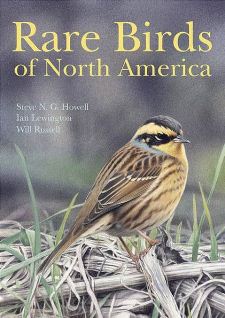 Rare Birds of North America
Rare Birds of North America
by Steve N. G. Howell, Ian Lewington, and Will Russell
From Princeton University Press:
Rare Birds of North America is the first comprehensive illustrated guide to the vagrant birds that occur throughout the United States and Canada. Featuring 275 stunning color plates, this book covers 262 species originating from three very different regions–the Old World, the New World tropics, and the world’s oceans. It explains the causes of avian vagrancy and breaks down patterns of occurrence by region and season, enabling readers to see where, when, and why each species occurs in North America. Detailed species accounts describe key identification features, taxonomy, age, sex, distribution, and status.
Rare Birds of North America provides unparalleled insights into vagrancy and avian migration, and will enrich the birding experience of anyone interested in finding and observing rare birds.
- Covers 262 species of vagrant birds found in the United States and Canada
- Features 275 stunning color plates that depict every species
- Explains patterns of occurrence by region and season
- Provides an invaluable overview of vagrancy patterns and migration
- Includes detailed species accounts and cutting-edge identification tips
The press copy is right – the plates are, indeed, stunning. How useful this will be to the average birder I’m not sure yet, but I have to say that I’m looking forward to perusing the accounts and learning about all these fantastic vagrants (many of which I’ve only read about on rare bird reports).
Rare Birds of North America
by Steve N. G. Howell, Ian Lewington, and Will Russell
Hardcover; 448 pages
Princeton University Press; February 16, 2014
ISBN: 978-0691117966
$35.00

Buy from Buteo Books
(based in the U.S.)
Buy from NHBS
(based in the U.K.)
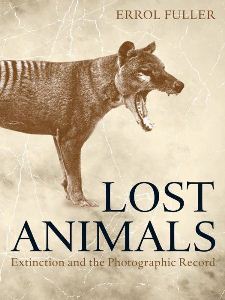 Lost Animals: Extinction and the Photographic Record
Lost Animals: Extinction and the Photographic Record
by Errol Fuller
From Princeton University Press:
A photograph of an extinct animal evokes a greater feeling of loss than any painting ever could. Often black and white or tinted sepia, these remarkable images have been taken mainly in zoos or wildlife parks, and in some cases depict the last known individual of the species. Lost Animals is a unique photographic record of extinction, presented by a world authority on vanished animals. Richly illustrated throughout, this handsome book features photographs dating from around 1870 to as recently as 2004, the year that witnessed the demise of the Hawaiian Po’ouli. From a mother Thylacine and her pups to birds such as the Heath Hen and the Carolina Parakeet, Errol Fuller tells the story of each animal, explains why it became extinct, and discusses the circumstances surrounding the photography.
Covering 28 extinct species, Lost Animals includes familiar examples like the last Passenger Pigeon, Martha, and one of the last Ivory-billed Woodpeckers, photographed as it peers quizzically at the hat of one of the biologists who has just ringed it. But the book includes rare images as well, many never before published. Collected together here for the first time, these photographs provide a tangible link to animals that have now vanished forever, in a book that brings the past to life while delivering a warning for the future.
Poignant and compelling, Lost Animals also includes a concise introduction that looks at the earliest days of animal photography, and an appendix of drawings and paintings of the species covered.
“A photograph of an extinct animal evokes a greater feeling of loss than any painting ever could.” So true. The photographs in this book aren’t glamorous, but they are incredibly moving. There have been plenty of books written on extinct animals, but this one takes a unique approach.
Lost Animals: Extinction and the Photographic Record
by Errol Fuller
Hardcover; 256 pages
Princeton University Press; February 2, 2014
ISBN: 978-0691161372
$29.95
Buy from NHBS
(based in the U.K.)
2013 was a great year for bird books, but based on the titles already announced 2014 may end up being even better! Here are some to be looking forward to.
-
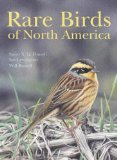 Rare Birds of North America
Rare Birds of North America
by Steve N. G. Howell, Ian Lewington, and Will Russell
February 16, 2014; Princeton University Press
This is the first comprehensive treatment of vagrant birds to North America. And what birder doesn’t love vagrants? You can get a look inside on Amazon .
.
-
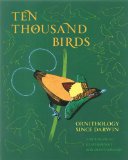 Ten Thousand Birds: Ornithology since Darwin
Ten Thousand Birds: Ornithology since Darwin
by Tim Birkhead, Jo Wimpenny, and Bob Montgomerie
February 16, 2014; Princeton University Press
I loved Birkhead’s The Wisdom of Birds, which also dealt with the history of ornithology. If his previous books are any indication, this one should be a great read.
-
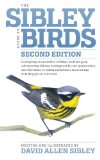 The Sibley Guide to the Birds of North America, Second Edition
The Sibley Guide to the Birds of North America, Second Edition
by David Allen Sibley
March 11, 2014; Alfred A. Knopf
This is the one that we are ALL looking forward to. The first edition was a game-changer, and I can’t wait to see this one.
-
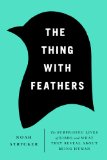 The Thing with Feathers: The Surprising Lives of Birds and What They Reveal About Being Human
The Thing with Feathers: The Surprising Lives of Birds and What They Reveal About Being Human
by Noah Strycker
March 20, 2014; Riverhead
According to the publisher, this is “An entertaining and profound look at the lives of birds, illuminating their surprising world—and deep connection with humanity.” Sounds like a book for me, especially since it’s written by Noah Strycker, who’s writing I’ve enjoyed in various birding magazines and his first book, Among Penguins: A Bird Man in Antarctica.
-
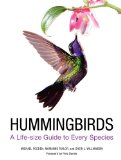 Hummingbirds: A Life-Size Guide to Every Species
Hummingbirds: A Life-Size Guide to Every Species
by Michael Fogden, Marianne Taylor, and Sheri L. Williamson
April 1, 2014; Harper Design
A book that illustrates every hummingbird species with life-sized photographs? What a fantastic idea! If you ever have the urge to drool uncontrollably, check out the extensive preview on Amazon .
.
-

 American Birding Association State Field Guides:
Colorado
American Birding Association State Field Guides:
Colorado and
New Jersey
and
New Jersey
April 1 and May 1, 2014 (respectively); Scott & Nix, Inc.
I’m not a fan of most state field guides, but I have faith that the ABA and guide authors Ted Floyd (CO) and Rick Wright (NJ) will do these right.
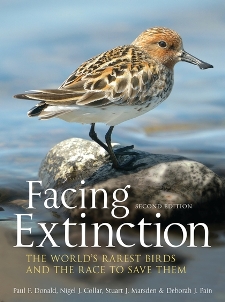 Facing Extinction: The World’s Rarest Birds and the Race to Save Them: Second Edition
Facing Extinction: The World’s Rarest Birds and the Race to Save Them: Second Edition
by Paul F. Donald, Nigel J. Collar, Stuart J. Marsden, and Deborah J. Pain
From Christopher Helm (Bloomsbury):
Almost two hundred species of birds have become extinct in the past 400 years, and a similar number today are in imminent danger of following them. The world’s conservationists are leading the fight to prevent the demise of these remaining critically endangered birds, with a fair degree of success. This new book examines the process and issues concerning extinction – how and why it happens and what can be done about it. Whilst man is to blame for many of the causes, such as persecution and habitat loss, species have become extinct on a regular basis since life began. After several thought-provoking introductory chapters, the book showcases about 20 species on the brink of extinction from around the world and describes the work that is being undertaken to save them. Some are success stories, but a few are not. This is a subject close to the hearts of all birders and ornithologists and this book, written by a team of leading conservationists, will strike a chord in most of them.
This book, with many great photos, looks at endangered birds from several perspectives and presents 20 detailed case studies on individual species or groups of birds. This book is relatively expensive here in the U.S., but is worth getting if you want the latest in bird conservation. But for most birders, I’d first recommend The World’s Rarest Birds or, if you want a bunch of not-as-detailed profiles of endangered birds, Atlas of Rare Birds
Facing Extinction: The World’s Rarest Birds and the Race to Save Them: Second Edition
by Paul F. Donald, Nigel J. Collar, Stuart J. Marsden, and Deborah J. Pain
Paperback; 320 pages
Christopher Helm (Bloomsbury); December 19, 2013
ISBN: 978-1408189665
$42.95

Buy from Buteo Books
(based in the U.S.)
Buy from NHBS
(based in the U.K.)
 Sport Optics: Binoculars, Spotting Scopes, and Rifle Scopes
Sport Optics: Binoculars, Spotting Scopes, and Rifle Scopes
by Alan R. Hale
From Hale Optics:
Virtually all people have an interest in sport optics products and they should have some basic knowledge about them prior to making a purchase. This book is intended to help consumers make the best decision possible for their needs.
- Intended for consumers who are interested in purchasing sport optics products, for sales and marketing people who sell or support these products, and for those who have an interest in optical products
- The most comprehensive and accurate book on sport optics ever written covering basic optical technology but written in an easy to understand language that is clear and interesting
- The optical knowledge in the book counteracts many optical misconceptions and errors as well as ad slogans and hype
The author has years of experience in this field, so if you want to know more about birding optics, this looks like a great resource.
Sport Optics: Binoculars, Spotting Scopes, and Rifle Scopes
by Alan R. Hale
Paperback; 182 pages
Hale Optics; 2013
ISBN: 9780989791601
$24.95

Buy from Buteo Books
(based in the U.S.)
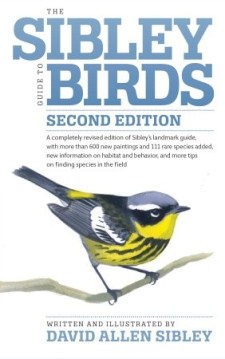 BirdWatching magazine has posted an interview with David Sibley, which includes a first look at the second edition of the Sibley Guide.
BirdWatching magazine has posted an interview with David Sibley, which includes a first look at the second edition of the Sibley Guide.
Some highlights:
- The trim size will be the same, but it will have 80 more pages than the last one.
- More species! 98 “non-exotic rare species” and 13 exotic species have been added.
- Updated, more detailed range maps that are zoomed in where appropriate.
- The illustrations are larger, and many have been revised.
My biggest question right now is regarding the family sequencing: will he use the same order as last time (taxonomic), or switch to something like that proposed by Howel, et al.? I would prefer the latter, but I have a feeling that will not be the case. Regardless, the publication date – March 11, 2014 – can’t get here fast enough.
 The Homing Instinct: Meaning and Mystery in Animal Migration
The Homing Instinct: Meaning and Mystery in Animal Migration

 Have You Heard the Nesting Bird?
Have You Heard the Nesting Bird? Searching for Pekpek: Cassowaries and Conservation in the New Guinea Rainforest
Searching for Pekpek: Cassowaries and Conservation in the New Guinea Rainforest Ten Thousand Birds: Ornithology since Darwin
Ten Thousand Birds: Ornithology since Darwin
 Rare Birds of North America
Rare Birds of North America Lost Animals: Extinction and the Photographic Record
Lost Animals: Extinction and the Photographic Record Rare Birds of North America
Rare Birds of North America Ten Thousand Birds: Ornithology since Darwin
Ten Thousand Birds: Ornithology since Darwin The Sibley Guide to the Birds of North America, Second Edition
The Sibley Guide to the Birds of North America, Second Edition The Thing with Feathers: The Surprising Lives of Birds and What They Reveal About Being Human
The Thing with Feathers: The Surprising Lives of Birds and What They Reveal About Being Human Hummingbirds: A Life-Size Guide to Every Species
Hummingbirds: A Life-Size Guide to Every Species
 Facing Extinction: The World’s Rarest Birds and the Race to Save Them: Second Edition
Facing Extinction: The World’s Rarest Birds and the Race to Save Them: Second Edition Sport Optics: Binoculars, Spotting Scopes, and Rifle Scopes
Sport Optics: Binoculars, Spotting Scopes, and Rifle Scopes




